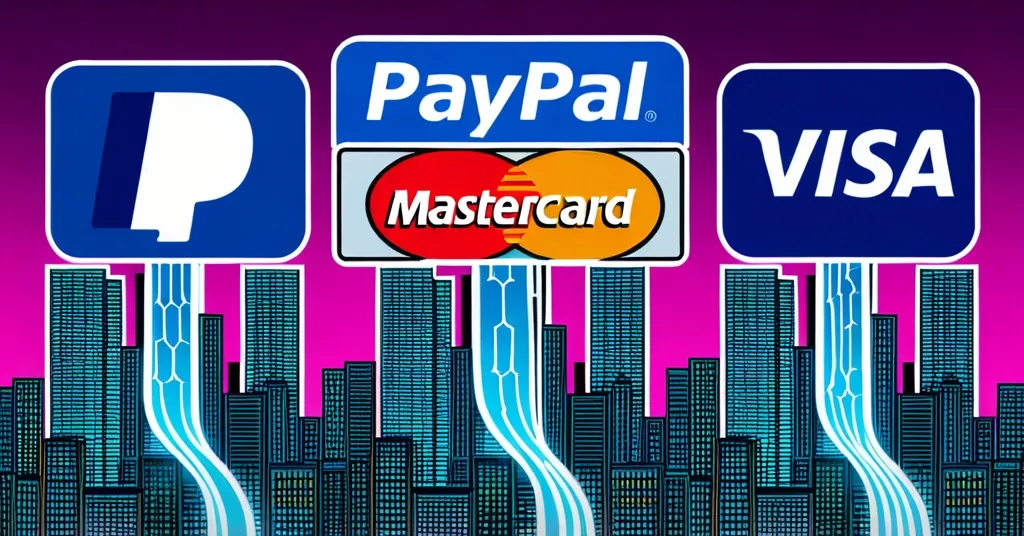Web2 Giants PayPal, Visa, Mastercard Propel Crypto Adoption by 2025

How Web2 Giants Like PayPal, Visa, and Mastercard Are Driving Cryptocurrency Adoption
By 2025, the cryptocurrency landscape has transformed dramatically, thanks to major Web2 companies like PayPal, Visa, and Mastercard, who are now at the forefront of integrating crypto into mainstream financial systems. These giants, once viewed as adversaries to the crypto world, are now key players in reducing entry barriers and enhancing user trust and familiarity with digital currencies.
- PayPal, Visa, and Mastercard integrate crypto services.
- Strategic partnerships between Web2 and Web3 drive adoption.
- Significant implications for global payment systems by 2030.
PayPal kicked off its crypto journey in 2020 by allowing users to buy, sell, and hold cryptocurrencies. By 2024, they took a bold step by integrating the stablecoin PYUSD, a digital currency pegged to the U.S. dollar to minimize volatility. This move not only solidified crypto’s credibility but also demonstrated PayPal’s commitment to becoming a central hub for digital assets. With a market cap soaring to over $700 million by 2025, PYUSD’s success underlines how trust in established brands can drive crypto acceptance. Stablecoins like PYUSD are crucial as they provide the stability needed for everyday transactions, making them a bridge between traditional finance and crypto.
Visa, on the other hand, has been busy settling over $2.5 billion in crypto-linked transactions since 2021, marking a new era for crypto in traditional finance. The launch of Visa+ in 2024 streamlined the process by linking digital wallets for instant payments, initially piloted with Coinbase. This initiative aims to make crypto transactions as seamless as using a traditional credit card. Visa’s efforts highlight the potential of crypto to revolutionize the payment ecosystem, particularly in Europe, where stablecoins are increasingly used for business-to-business and treasury transactions.
Mastercard, not to be left behind, is pushing the boundaries with crypto debit cards and piloting blockchain payments. Their launch of the Mastercard Crypto Credential in the UAE and Kazakhstan by 2025 showcases their dedication to simplifying and enhancing trust in cryptocurrency transactions globally. As Yagub Zamanov from AFSA puts it, “These giants are effectively turning ‘what’s a wallet?’ into ‘oh, I already have that.'” Mastercard’s efforts are a testament to their deep dive into the crypto pool, not just a mere toe-dip.
The integration extends beyond these giants. Crypto.com, boasting over 80 million users, recently added PayPal as a payment method, reflecting the broader trend of Web2 giants partnering with crypto platforms. This move makes it easier for users to enter the digital asset space. Meanwhile, Mercuryo has been forging partnerships with Polygon and powering euro crypto cards with Mastercard, focusing on localized solutions like SEPA transfers in Europe, which are essentially European bank transfers.
The collaboration between MetaMask and Mercuryo is particularly noteworthy. They’ve simplified crypto onboarding, allowing users to buy crypto with a bank card in under a minute, and even offer no-identity-verification purchases up to €699, making it as easy as buying a cup of coffee. As one expert remarked, “It’s a full-circle play: buy crypto fast, spend it faster.” This ease of access is crucial for mainstream adoption, but it also raises the question: is it too easy?
These developments are backed by shifting public perceptions. A 2024 Deloitte survey revealed that 62% of U.S. adults would try crypto if offered by a known brand, indicating a significant shift in trust. Moreover, Statista predicts that by 2030, 20% of global payments could involve crypto if integration continues to accelerate, hinting at a future where crypto is seamlessly integrated into every transaction.
However, we must remain vigilant. While these integrations are a boon for adoption, they also raise questions about centralization and the true spirit of crypto. Are these giants truly embracing decentralization, or are they merely co-opting it for their own gain? It’s a delicate balance between welcoming the mainstream and preserving the ethos of decentralization that attracted many to crypto in the first place.
One of the more pleasant surprises to have surfaced in recent years has been the willingness of businesses once branded the enemy of crypto to support its infiltration into every payment system.
The regulatory environment plays a critical role in this narrative. The U.S. government’s pro-crypto policies, such as the appointment of David Sacks as the AI and Crypto Czar and the proposed GENIUS Act, create a supportive backdrop for stablecoin adoption. Yet, the real challenge lies in whether these giants can maintain the trust they’ve built while navigating the complexities of regulation and decentralization.
So, what does this mean for the future of crypto? Are we on the cusp of a financial revolution, or is this just another chapter in the saga of tech giants co-opting the next big thing? Only time will tell, but one thing is clear: Web2 giants are no longer the NPCs playing a bit part in crypto adoption; they’re web3’s wingmen, dragging the industry from the fringes to the forefront.
Key Takeaways and Questions
- What role are Web2 giants playing in the adoption of cryptocurrencies?
Web2 giants like PayPal, Visa, and Mastercard are crucial in mainstreaming cryptocurrency adoption by integrating crypto services into their platforms, leveraging their extensive user bases to reduce barriers and enhance user trust.
- How have PayPal, Visa, and Mastercard specifically contributed to crypto adoption?
PayPal integrated PYUSD, reaching 430 million users. Visa settled over $2.5 billion in crypto-linked transactions and launched Visa+. Mastercard pushes crypto debit cards and pilots blockchain payments, all facilitating easier access to cryptocurrencies.
- What are some examples of partnerships between Web2 and Web3 entities?
Examples include PayPal and Visa’s collaboration on crypto payouts, Mastercard’s partnerships with MetaMask and Trust Wallet, and Mercuryo’s partnerships with Polygon and MetaMask to simplify crypto onboarding.
- How does the integration of cryptocurrencies by Web2 companies affect traditional users?
For traditional users, integration means reduced barriers to entry, a more familiar user experience, and potential everyday utility of crypto, with 62% of U.S. adults open to trying crypto if offered by a known brand.
- What are the future implications of Web2 giants’ involvement in crypto for global payment systems?
By 2030, 20% of global payments could involve crypto if integration continues, suggesting a future where crypto enhances efficiency and reduces costs for cross-border payments and micropayments.



